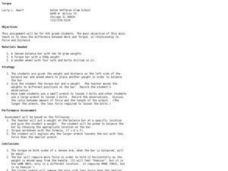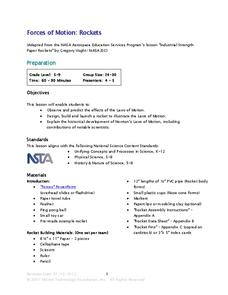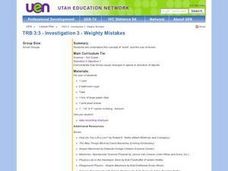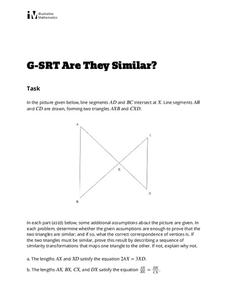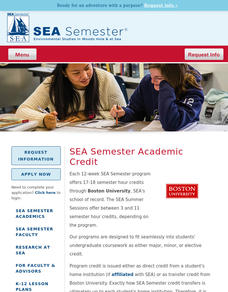Curated OER
Introduction to Work
Fifth graders define work, force, and energy and calculate work done using a simple formula. They observe the teacher using an Equi-beam and identify the fulcrum, calculate different work problems, and participate in a class discussion.
Curated OER
How are torque and work different?
Sixth graders explore how torque and work are different. In this torque lesson, 6th graders will understand the relationship between torque and work as it applies to force and distance. Students will be assessed on their conclusions of...
Micron Technology Foundation
Forces of Motion: Rockets
Young scientists design a rocket to launch using Newton's Laws of Motion in order to discover for themselves the forces of motion.
Curated OER
Rules of Force and Motion
Students view a video and complete experiments with force and motion. In this force and motion activity, students examine small pieces and how they affect the motion of a toy car. Students also experiment with sand paper, bubble wrap...
Curated OER
Work in Linear Mechanical Systems
Young scholars are able to identify the units associated with linear work. They are able to calculate the work done on an object. Students discover how the force exerted on an object and the distance the object moves determines the...
Curated OER
Measuring Work
Students explore what work is, measure work done in moving an object, and tell how energy is related to work in both machines and the human body. For this measuring work lesson plan, students walk up a flight of stairs, measure the...
Curated OER
Inclined Plane and Pulley
Students describe how inclined plane and pulleys make work easier. In this physics lesson plan, students calculate work done and mechanical advantage of both simple machines. They collect data from the experiment and construct graphs.
Curated OER
Breaking Energy
Students understand that the energy required to break a piece of wood can be computed by determining the force and distance (work) that snaps it. Kinetic energy is the system can be computed if its mass and velocity are known.
Curated OER
Work and Power
Students investigate work and power. In this energy lesson, students use the scientific method process to explore how much work and power it takes for a person to climb a stair case.
Curated OER
Measuring Work
Students examine how work is measured and name the units that are used to measure it. For this science lesson students create their own story problem.
Curated OER
Universal Gravitation Worksheet
In this universal gravitation worksheet, students answer thirteen questions using the equation for universal gravitation, and force equals mass times acceleration.
Cornell University
The Physics of Bridges
Stability is key when building a bridge. Scholars explore the forces acting upon bridges through an analysis of Newton's Laws and Hooke's Law. The activity asks individuals to apply their learning by building a bridge of their own.
Curated OER
Forces Applied to an Object
Fourth graders predict, observe, and compare what happens when a force is applied to an object. In this forces lesson, 4th graders complete a 'swinging hammer' activity to learn about forces and motion.
Curated OER
TECH:Flight Simulator (Trans)
Microsoft's Flight simulator is the focal point of this lesson. By participating in this activity, teenagers role-play what is necessary for piloting an airplane. They explore the concepts of flight. You will need to familiarize yourself...
Curated OER
Investigation 3 - Weighty MistakesStudents
Third graders investigate levers and the concept of work.
Illustrative Mathematics
Are They Similar?
Learners separate things that just appear similar from those that are actually similar. A diagram of triangles is given, and then a variety of geometric characteristics changed and the similarity of the triangles analyzed. Because the...
Curated OER
Fluid Friction
Students, using wood blocks and model boats, investigate how the shape of an object affects friction it encounters as it is drawn through a towing tank.
Curated OER
Breaking Energy
Pupils experiment with the amount of work required to break a piece of wood by hanging masses from a string attached to a thin dowel of wood. At the completion of activity, students calculate if a fast moving hand could break the dowel.
Curated OER
The Physics of the Planets: How 16th and 17th Century Physicist Helped Us Understand Our Solar System
Eighth graders draw the paths of the planets in the solar system. In this astronomy lesson plan, 8th graders calculate speed of objects using distance and time information. They research about the work of scientists in the 16th and 17th...
Curated OER
Simple Machines
Third graders are introduced to the six types of simple machines and discover how they make tasks easier. In groups, they rotate between stations to experiment with the different types of simple machines. To end the activity, they make...
Curated OER
Easy Does It
Young scholars discover how inclined planes make work easier as they make mathematical predictions and prove their predictions through experiments.
Cornell University
Catapult
Studying levers couldn't be more exciting! Learners build their own catapults and test the results as they make adjustments to the fulcrum. They compete against other groups to create the most accurate apparatus.
Curated OER
A Model of a Scanning Tunneling Microscope
Ninth graders explain how a scanning tunneling microscope works. In this chemistry lesson plan, 9th graders construct atomic models and simulate how their images appear under the STM. They discuss the limitations of their atomic model.
Curated OER
Pulley Power
Third graders engage in a manipulative experiment in the mechanical advantage of simple machines. It graphically demonstrates the change in magnitude of applied force when using simple machines. Great for ESL to discover the ratio...



